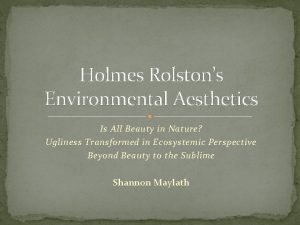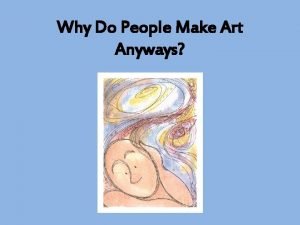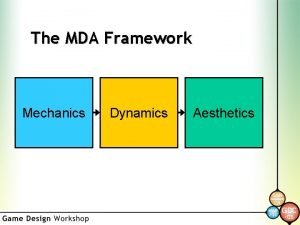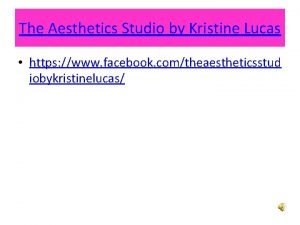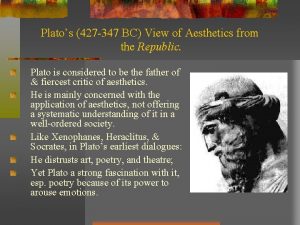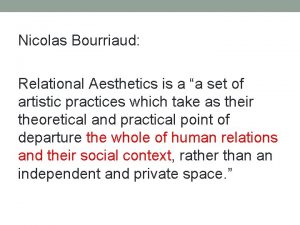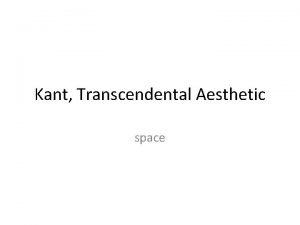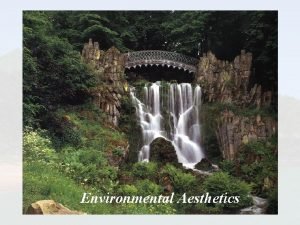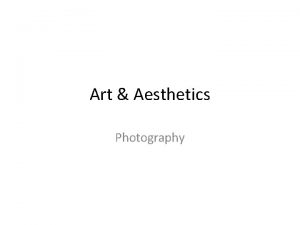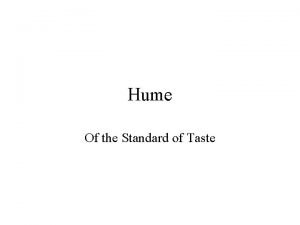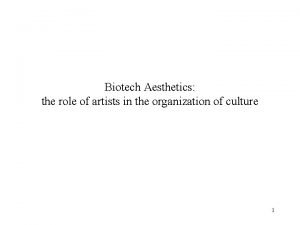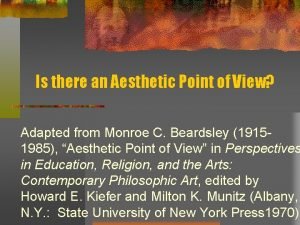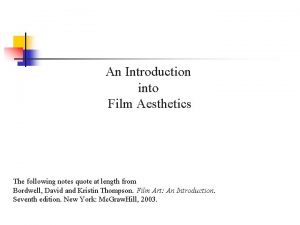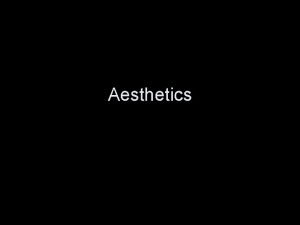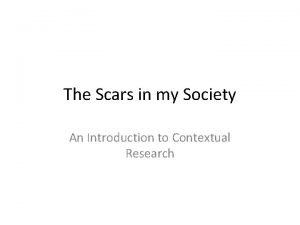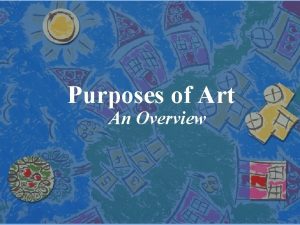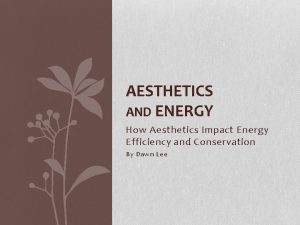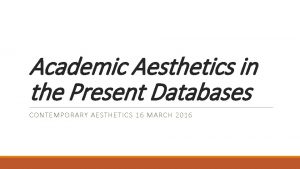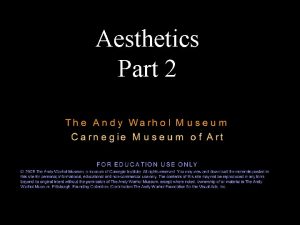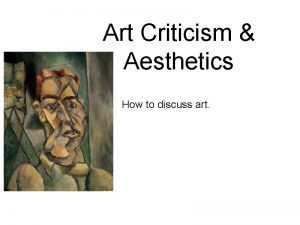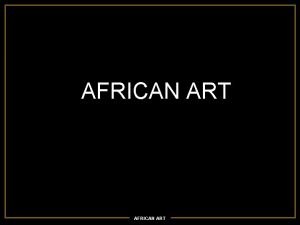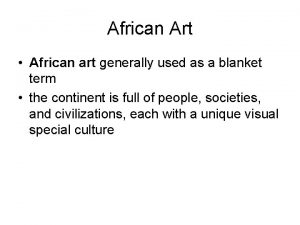African Art African Artists and Aesthetics Purposes To





























- Slides: 29

African Art

African Artists and Aesthetics Purposes: • To identify the position of the artist in various African societies. • To consider the creative process. • To evaluate aesthetic principles from African perspectives.

"Jijora" = Mimesis or relative likeness • Which of these two sculptures would you consider to be an example of "jijora"? • Would you consider these to be actual portraits or idealistic representation of people?

"Odo" = Relative youthfulness • How does the texture of this object convey the impression of youthfulness? • What are the social qualities associated with youthfulness?

"Pipe" = Completeness • Why would an artist choose to create a complete figure as opposed to a partial figure? • Can you identify the distinguishing features that convey status on both figures?

"Gigun" = Relative straightness • Would you consider these figures relatively straight? • Do the lines of these figures convey a feeling of balance?

"Wiwulo" = Functionality • Consider how these shrine sculptures intensify worship?

Saharan Rock Art

• Engravings and paintings on rock surfaces found in the Tassili Plateau in modern Algeria. • Over 30, 000 sites have been discovered. • Rock art indicates that there has been human habitation in the Sahara from 8, 000 B. P.

Sothern African Rock Art

Characteristics: • The painting has been interpreted as representing healers in altered states of consciousness. Healing rituals are performed by the San today. • In this painting the healers are surrounded by observers who appear to be clapping their hands.

Nok Art

• Found in north central Nigeria off the edge of the Jos plateau. • The oldest known example of terracotta sculpture in Africa, south of the Sahara. • Dates from 2500 -800 B. P (500 BC to 200 AD). • Wide diversity of subject matter depicted with considerable variation in style, treatment and scale. • Highly skilled in the creation of fulllength human figures. Nok Head from Jemaa, Nigeria 5 th century B. C. E. terracotta 9 13/16 in. high

Some Stylistic Characteristics of Nok Art: • Elaborate coiffure. • Cylindrical heads. • Pierced eyes, nose, mouth, and ears. • Semi-circular/Triangular eyes and lids. • Ears set back, often low and small. • Flared nostrils. Nok Head from Jemaa, Nigeria 5 th century B. C. E. terracotta 14 3/16 in. high

Igbo-Ukwu Art

• Art comes from archaeological sites found in eastern Nigeria. • Consists of objects made from bronze, terracotta, beads and ivory. • They are believed to date to around the 1200 B. P (800 A. D). • Objects discovered in ancient burial chambers, shrines, and storage areas. • Made by sophisticated bronze casting techniques. • Objects include bronze pendants, bowls, and shells. Equestrian figure on fly-whisk hilt from Igbo-Ukwu, Nigeria 9 th to 10 th century copper -alloy bronze 6 3/4 in. high

• Pendant representing a human head with scarification marks. • One of the few human representations at Igbo. Ukwu.

• Triton shell with elaborate surface decoration including flies, crickets, frogs, and snakes. • The form of this 9 th century bronze bowl appears to be based on a large globular gourd. • It is decorated on the outside with raised horizontal and vertical loops in bands. • This unique vessel has been described as one of the most sophisticated examples of Igbo. Ukwu bronzes. • It is a water vessel resting on a stand encasted by ropework.

Ife Art

• Art comes from archaeological sites found in western Nigeria. • Consists of objects made from terracotta, bronze, and stone. • Objects date 1000 -500 B. P (1000 and 1500 A. D). • Believed to be created for the ruling elite. • Idealized naturalism. • Full length figures and busts are common. • Figures are sometimes heavily beaded. King from Ife, Nigeria 11 th to 12 th century zinc brass 18 1/2 in. high



Benin Art

• Found in western Nigeria. • Objects consist of busts and plaques depicting important historical events. • Art objects are predominantly made from bronze but also include ivories. • Busts are commemorative heads for members of the royal family. • Objects divided into three periods: early, middle, and late. Ivory belt mask of a Queen Mother (Idia) from Benin, Nigeria mid-16 th century ivory and iron 9 3/8 in. high

Early/Warrior King Period: 600 -400 B. P (1400 -1600 A. D) Characteristics: • Thin castings. • Busts depict beaded collars snugly around necks. • Delicately rendered facial features. See awareness of bone and flesh. • Careful treatment of hair. • Queen mother busts with distinctive coral headdress (curving cone) are common. Bust of King Bust of Queen Mother

Late/Restoration Period: 300 -100 B. P (1700 - 1897 A. D). Characteristics: • Casting is thick and not carefully done. • Faces become inflated, the headdress has winged extensions, and flanges appear on the bottom of the busts. • Beaded collars rise above the mouth. • Eyes are more un-realistic. • Destruction of the empire due to British colonization. • Ivory objects are common. Bust of King Ivory Tusk

STOP!

Altar of the Hand from Benin, Nigeria 17 th to 18 th century brass 17 1/2 in. high

During the sixteenth and seventeenth centuries, a remarkable series of works were created to adorn the exterior of the royal palace in Benin City. A seventeenth-century Dutch visitor to the court of Benin, Olfert Dapper, described the sprawling palace complex—with its many large courtyards and galleries—as containing wooden pillars covered from top to bottom with rectangular cast brass plaques. These plaques are understood to have autonomous meaning and to tell complex narratives in relationship to one another. At some point the plaques were removed from the palace facade, as they were no longer there when the British arrived in the region. One scholar has surmised that they "were kept like a card index up to the time of the Punitive Expedition, and referred to when there was a dispute about courtly etiquette. " The authors of such works were far more concerned with the communication of hierarchies and status than in capturing individual physical features. These plaques conform to a convention of "hierarchical proportions" wherein the largest figure is the one with the greatest authority and rank. In this example, it is a warrior chief. He is in the center, flanked on either side by soldiers of lesser rank. Regalia and symbols of status are emphasized above all other aspects of the subject depicted. For example, the warrior is shown with leopard-spot scarification marks and a leopard-tooth necklace, which associate him with the stealth, speed, and ferocity of the leopard. As "king of the bush, " the leopard is one of the principle symbols of Benin kingship. Additionally, the warrior chief wears a coral-studded helmet and collar, a lavish wrap, and a brass ornament on his hip. In his left hand he carries a ceremonial sword, a gesture of honor and loyalty, and holds a spear in his other hand. The servile status of the figures flanking the warrior chief is indicated by the objects they carry. One attendant has a fan used to cool the warrior chief, the other a trumpet to announce his presence. A third attendant brings a box containing an offering of kola nuts for the oba (king). Warrior Chief and Attendants from Benin, Nigeria ca. 1550 -1650 brass 18 3/4 in. high
 Hegel philosophy of fine art summary
Hegel philosophy of fine art summary Principles of design radial balance
Principles of design radial balance Artists create art to express personal feelings
Artists create art to express personal feelings Opa art
Opa art Beast and beauty aesthetics
Beast and beauty aesthetics 5 purpose of art
5 purpose of art Gestalt psychology laws
Gestalt psychology laws Racquel aesthetics
Racquel aesthetics Ideo pleasure
Ideo pleasure The concept of aesthetics
The concept of aesthetics Mechanics dynamics aesthetics examples
Mechanics dynamics aesthetics examples The aesthetics studio
The aesthetics studio Platos aesthetics
Platos aesthetics Nicolas bourriaud relational aesthetics
Nicolas bourriaud relational aesthetics Transcendental aesthetics
Transcendental aesthetics Example of environmental aesthetics
Example of environmental aesthetics Aesthetics in photography
Aesthetics in photography Hume aesthetics
Hume aesthetics Biotechnology aesthetics
Biotechnology aesthetics Introduction to aesthetics
Introduction to aesthetics Applied media aesthetics
Applied media aesthetics Mechanics dynamics aesthetics examples
Mechanics dynamics aesthetics examples Point of view aesthetic
Point of view aesthetic Aesthetics developers
Aesthetics developers Nuffield aesthetics singapore
Nuffield aesthetics singapore Film aesthetics
Film aesthetics Gk aesthetics
Gk aesthetics Banobagi doctors
Banobagi doctors Exaggeration in stereo hearts
Exaggeration in stereo hearts Scars in the society
Scars in the society




